Wigan Corporation Tramways
History
Wigan became a tramway owner around June 1892 (the precise date has not be recorded), when it bought the lines of the former Wigan Tramways Company from receivership, which it then leased to the WTCo's successor, the Wigan and District Tramways Company. The lines were narrow gauge (3ft 6ins) and steam operated. Although a new steam line was subsequently built by the corporation and leased to the company, the corporation's thoughts eventually turned to electric traction, and on the 15th July 1898, it acquired powers to convert the system, as well as to operate it itself.
The W&DTCo was, however, keen to build and operate the system, and to this end had reached a provisional agreement with the British Electric Traction Company. At this time, the BETCo was actively purchasing steam and horse tramways with a view to conversion to electric traction, and would eventually go on to own, part-own or lease almost 50 tramway concerns across the British Isles. The corporation was, however, reluctant to see its system operated by a company, especially one headquartered in London. Construction of the first new line began on the 11th June 1900, to a gauge of 3ft 6ins, with the first overhead electric, municipally operated service running on the 25th January 1901.
Although more new lines were opened later that year, the corporation would, sooner or later, need to convert the existing steam lines, and for that it needed to buy the company out of its leases or reach some other accommodation that would see steam services gradually phased out. The corporation chose to acquire the company, but quite bizarrely, it agreed to pay well over the odds, especially considering that it already owned all bar a few hundred yards of track, the tramcars and engines being of questionable value; moreover, a significant number of valuable buildings were excluded from the deal. The transaction was nevertheless completed, the corporation taking over operation of the steam lines on the 30th September 1902, and the company no doubt gleefully distributing the corporation's largesse amongst its shareholders. Thereafter, the steam lines were gradually converted to electric traction, the last steam service running on the 26th September 1904.
Unfortunately, the tramway suffered enormously from decisions taken at council level (as opposed to the tramway's management), the most damaging of which was an insistence on narrow gauge lines. This decision not only put paid to all thoughts of through running (all the adjacent systems were standard gauge), but also flew directly in the face of several smaller local authorities, into whose territories Wigan hoped to run. Although not a disastrous decision in and of itself, the council was subsequently forced to perform a volte face under pressure from the neighbouring authorities, but only after several lines had already been built to the narrower gauge. Whilst some of these lines were converted to standard gauge, others were not, the council thereby opting to operate two gauges, with all the inefficiencies inherent in that, a situation that persisted for almost all the tramway's life. As a result, electrification was significantly more expensive than it needed to have been, leaving the tramway to service excessive loan repayments. This was further compounded by decisions to build lines serving very sparsely populated districts, then setting the fares too low (again against the advice of the tramway's management), and charging excessive electricity costs, which effectively meant that the tramway was subsidising domestic and commercial electricity consumers. Despite having the good sense to seek a report on their struggling tramway enterprise from an independent and well-respected tramway expert (Mallins of Liverpool Corporation Tramways), the council then proceeded to either ignore most of his recommendations or fail to implement them, a feat it subsequently repeated in 1921 (this time involving J B Hamilton of Leeds Corporation Tramways). The tramway, despite carrying large numbers of passengers, was therefore in constant financial difficulties, often severe.
Like most tramway systems, Wigan's emerged from the Great War in very run-down condition, with a large backlog of maintenance work and renewals. Although the corporation experimented with a few bus services in late 1919, they made heavy losses and were all withdrawn by late 1922. The corporation had meanwhile chosen to invest in the tramway, ordering new tramcars, rebuilding others and relaying track. The narrow-gauge lines to Aspull and Martland Mill were particularly bad, but rather than convert them both to standard gauge, half of the former was re-gauged (re-opened on the 22nd December 1923), the outer portion being replaced by buses, whilst the latter was converted to trolley bus operation (opened 7th May 1925).
Bus services were steadily expanded during the second half of the 1920s, and in 1926, yet another report on the tramways recommended that they (and the trolleybuses) should be replaced with buses as and when the track condition demanded or local authority leases expired. The tramway routes were gradually closed during 1930 and 1931, some of them having only had the track replaced a handful of years earlier, the last tram running on the 28th March 1931. The trams were followed into oblivion by their erstwhile replacements — the trolleybuses — only six months later on the 30th September 1931.
At its maximum extent, Wigan Corporation Tramways operated 24.83 miles of tramway, 19.23 miles owned by the corporation, 1.99 miles by Ashton-in-Makerfield Urban District Council, 2.45 miles by Ince-in-Makerfield UDC, 0.45 miles by Hindley UDC and 0.32 miles leased from the South Lancashire Tramways Company, who in turned leased it from Hindley UDC. The system comprised lines: northwards to Standish; northeastwards to Aspull; eastwards to Hindley; southeastwards to Platt Bridge; southwards to Ashton-in-Makerfield via both Poolstock and Goose Green; westwards to Abbey Lakes (Orrell); and northwestwards to Martland Mill. The tracks of the WCT approached those of the SLTCo at Ashton-in-Makerfield, Platt Bridge and Hindley, but were only ever connected at Ashton and Hindley, and then only very late on in the system's life (26th October 1926 and the 21st April 1928, respectively). A joint through service between St Helens and Wigan, via Ashton, was subsequently introduced — over SLTCo tracks leased to St Helens Corporation — with St Helens Corporation Tramways cars appearing in Wigan, and those of the WCT appearing in St Helens. This service was, however, only to last for 13 months before being withdrawn. Other than WCT tramcars running through to terminate in Market Street in Hindley, no through running was undertaken over this connection.
Uniforms
Wigan Corporation officially became a steam-tramway operator on 30th September 1902, when it took over from the Wigan and District Tramways Company. The corporation operated steam services for almost two years, until their withdrawal on the 26th September 1904. Only a single surviving photograph of steam-tramway staff can be securely dated to this period, and this clearly shows that the Corporation, unlike the W&DTCo, issued uniforms to conductors. The uniform jackets were identical to those issued to electric tramcar crews, and probably bore the same insignia. Although photographic evidence is lacking, the first caps were probably of the drooping-peak type, these being superseded by tensioned-crown peaked caps prior to the end of steam services, by which time, they carried a brass script-lettering grade badge — 'Conductor' — along with badge incorporating a depiction of Wigan Moot Hall within a wreath (see below). The Moot Hall was the central device on the Wigan town seal, and was used extensively by Wigan prior to the official grant of arms in 1922.
Crews working the first electric services, which commenced in January 1901, were provided with single-breasted jackets bearing five buttons (presumably brass — see link), two breast pockets (with button closures), stand-up collars and epaulettes (with button fastenings). The stand-up collars did not carry any badges, which seem instead to have been borne on the epaulettes; although their precise form remains unclear, they were probably employee numbers. Somewhat surprisingly, the basic style of the uniform does not appear to have altered over the entire 30-year life of the tramway.
Caps were initially of the drooping-peak type, and bore a brass script-lettering grade badge — either 'Conductor' or 'Motorman' — above which, a small municipal-device badge was worn; the latter almost certainly depicted Wigan Moot Hall (see below). The caps were changed at some point during the Edwardian period, certainly by late 1904, to a tensioned-crown peaked type; these may have borne the larger Moot Hall and wreath cap badge, though this is yet to be confirmed photographically. By 1906, the municipal-device cap badges had been dispensed with, tramcar crews thereafter wearing only a grade badge on their caps. Several photographs have survived from the Great War which show motormen without any cap badges; whether this was official policy or problems with supply is unclear.
The wearing of white rain covers on the caps was compulsory between May 1st and September 30th.
Motormen and conductors were also issued with long greatcoats — these had five pairs of buttons and high fold-over collars; during the early years these garments had parallel pairs of buttons, but in later years a lancer style appears to have been used, with the button pairs narrowing from top to bottom. Both styles of greatcoat were completely devoid of insignia. Motormen were also provided with waterproof capes.
In 1922, the County Borough of Wigan was officially granted municipal arms, and photographs taken from the mid 1920s onwards clearly show tramcar crews wearing a cap badge comprising the new municipal arms within a wreath (see below). At the same time, the employee numbers appear to have been moved to the jacket collars, some individuals wearing them on one side only, and others on both sides.
Inspectors wore single-breasted jackets without buttons (probably with hook and eye closures) and stand-up collars; it is probable that the collars carried the grade 'Inspector', more than likely in embroidered script-lettering. Drooping-peak caps were most probably worn in the early years, these at sme point being superseded tensioned-crown caps. Although inspectors' caps certainly bore the large Moot Hall badge during the steam-tramway era, it is unclear what cap badges were worn subsequent to this.
Conductresses, who were employed during the Great War to replace men lost to the armed services, were issued with long skirts, and long single-breasted jackets with breast pockets (with button fastenings) and a waist belt. Round bonnets were worn; these probably bore the same badges as their male colleagues' caps. Although at least one inspectress was employed during the Great War, Wigan never made use of motorwomen (female drivers).
A report conducted in 1910 stated that Wigan Corporation Tramways Traffic Department had 9 clerks, 1 chief inspector, 7 inspectors, 61 motormen, 66 conductors, 6 pointsmen and 2 parcel boys.
Further reading
For a detailed history of Wigan Corporation Tramways, as well as its steam and horse-tramway predecessors, see 'The Tramways of Wigan' by E K Stretch; Manchester Transport Museum Society (1978).
Images
Steam tram drivers and conductors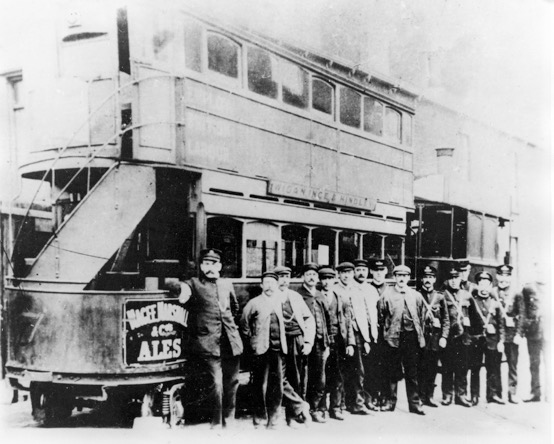
Wigan Corporation Tramways staff pose with an unidentified steam tram and Trailer No 7 outside Hindley Depot — photo undated, but more than likely taken to mark the end of steam services on 26th September 1904. 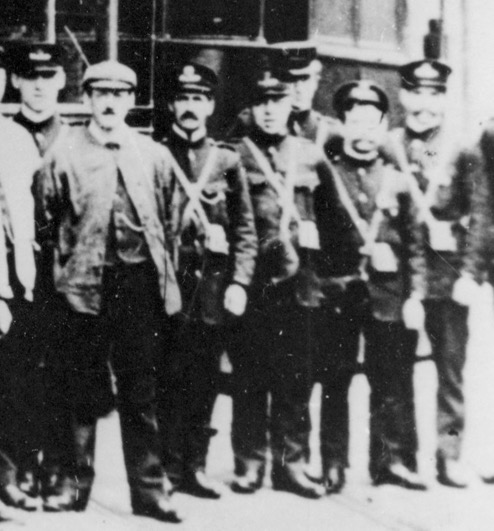
Although of rather poor quality, this image does show that all the conductors appear to be wearing uniforms identical to their colleagues operating the electric tramcar services, but with tensioned-crown caps rather than the drooping-peak style worn by the first electric tramcar crews, suggesting that the latter type had been replaced by 1904. The conductors, as well as the inspector (front left in main photo), are clearly wearing a round cap badge — larger than that seen in earlier electric era images (see below), along with what is very probably a script-lettering grade badge ('Conductor'). The round badge is almost certainly the brass 'Moot Hall and Wreath' badge depicted below. 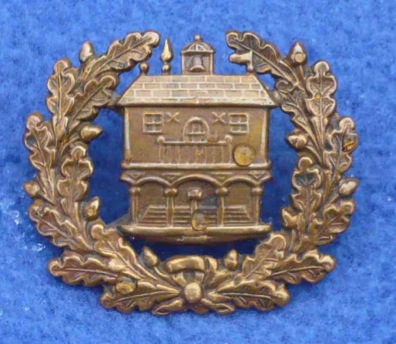
Wigan Corporation Tramways cap badge — brass. Although confirmatory photographic evidence is sketchy, this badge appears to have been used on the caps of steam-tramway conductors and inspectors, at least by 1904. Author's Collection.
Motormen and conductors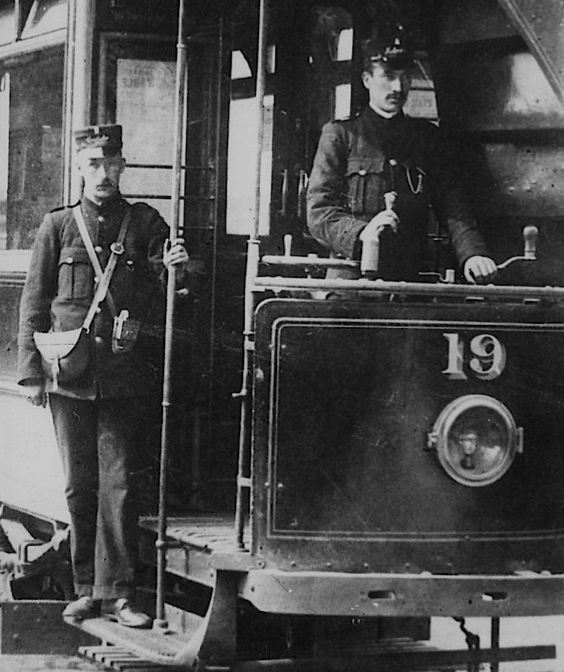
A conductor and a motorman pose aboard Tramcar No 19 on the Boar’s Head route — date unknown, but most probably taken in 1902/3. An epaulette badge or number is just visible on the motorman’s right shoulder. Both men are wearing drooping-peak caps bearing script-lettering grade badges — either 'Conductor' or 'Motorman' — along with a small badge, very probably a depiction of Wigan Moot Hall. . Author's Collection.
This general pattern of municipal cap badge is probably that used on tramcar crew caps at the commencement of electric operations — nickel. Tramcar crew cap badges would in all likelihood have been brass rather than nickel, the latter material being employed on Wigan Borough Police uniform collars. Author's Collection.
General pattern script-lettering grade cap badges (brass), of the type worn by WCT tramcar crews during the early years of electric operation. Author's Collection.
Tramcar No 48 and its crew standing at the terminus in Upholland (later called Abbey Lakes) — photo undated, but probably taken shortly after the extension to this point opened (11th April 1906).
An enlargement of the above photograph showing the conductor and the motorman. Both men are wearing tensioned-crown peaked caps bearing script-lettering grade badges. seemingly without the Moot Hall badge. Their double-breasted greatcoats appear to be completely devoid of insignia.
A group of Wigan Corporation Tramways employees — photo undated, but probably taken in the early-to-mid 1920s. Author's Collection.
An enlargement of the above photograph showing some of the men. The jacket collars appear to carry employee numbers, and the caps a new pattern of badge based on the official arms of Wigan, granted in 1922.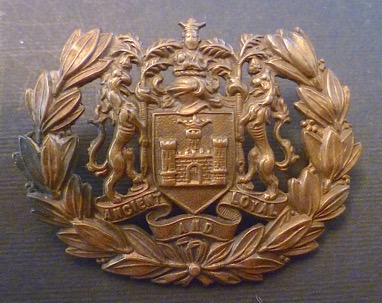
Late-period cap badge worn from around 1922 through to closure — brass. Author's Collection.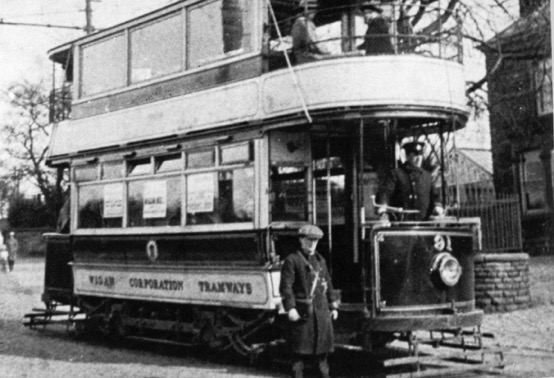
A WCT conductor, informally attired, and a motorman, with Tramcar No 91 at the Abbey Lakes terminus — photo undated, but probably taken during the late 1920s. Photo courtesy of the Tramways and Light Railway Society, with thanks to David Voice.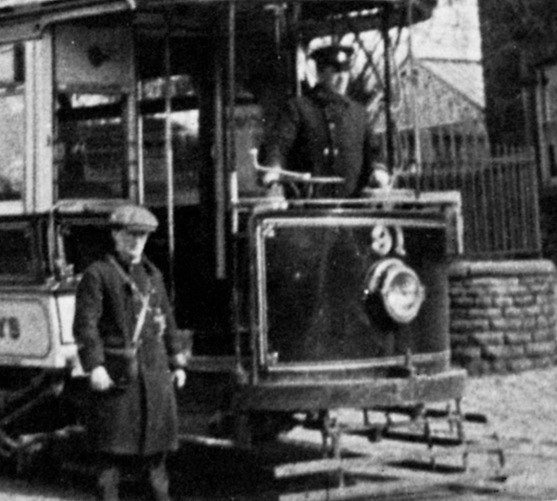
An enlargement of the above photograph showing the motorman, whose cap carries the 1922 pattern of municipal-cap badge.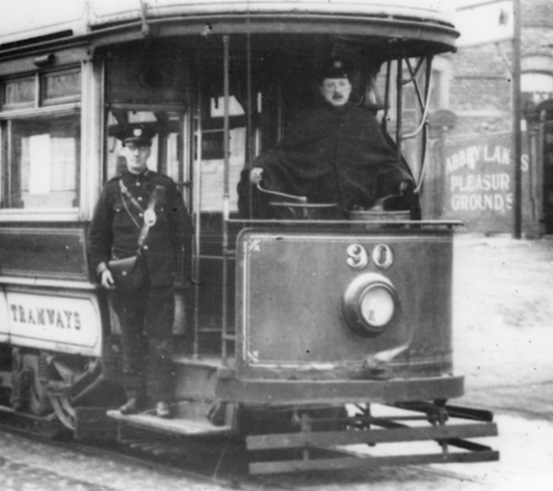
A conductor and a motorman pose for the camera on the last day of operation (28th March 1931) with Tramcar No 90 at the Abbey Lakes terminus. Photo courtesy of the Tramways and Light Railway Society, with thanks to David Voice.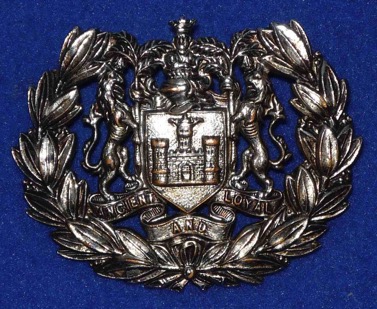
Wigan Corporation Tramways/Transport cap badge — chrome. Although the Wigan system closed in 1931, which was before the widespread adoption of chrome as a badge material (see link), the fact that chrome Wigan Corporation Tramways buttons have survived, suggests that chrome cap badges may possibly also have been issued towards the very end of the tramway system's life. This particular example belonged to Charles Makin, a Wigan Corporation Transport bus driver (see photo below). Author's Collection.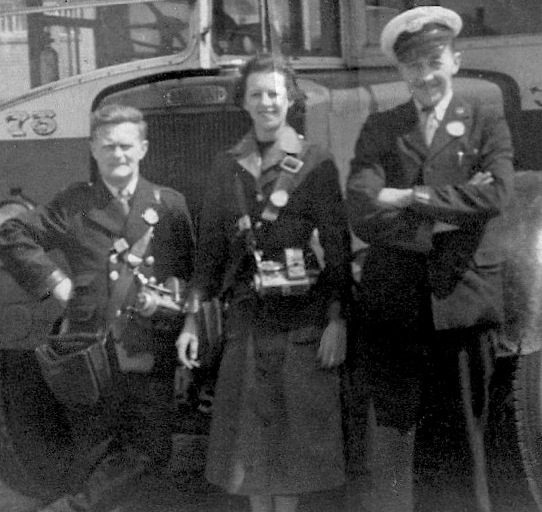
Bus driver No 46, Charles Makin (above right), owner of the late-period cap badge shown above — photo taken during the 1950s. Although long after the demise of the tramway, earlier photos (see above) show tramway staff wearing the identical form of cap badge.
Senior staff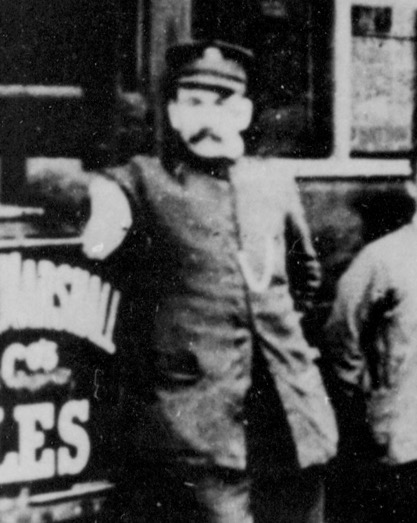
An enlargement of the 1904 steam-era shot above showing the inspector. His tensioned-crown cap probably bears the standard 'Moot Hall & Wreath' cap badge, which was introduced around 1903/1904.
Female staff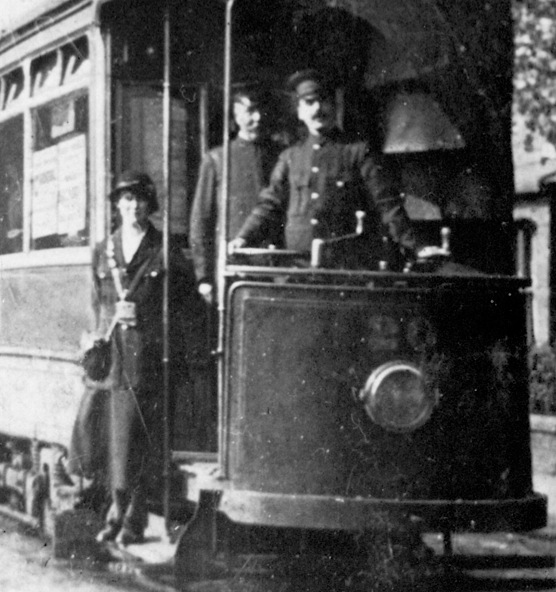
A conductress, an inspector and a motorman pose with Tramcar No 20 on a service for Aspull — photo undated, but almost certainly taking during the Great War. The inspector is wearing a typical single-breasted tramway inspector's jacket and a tensioned-crown peaked cap. The motorman's cap and jacket collars appear to be completely devoid of insignia. Photo courtesy of the Tramways and Light Railway Society, with thanks to David Voice.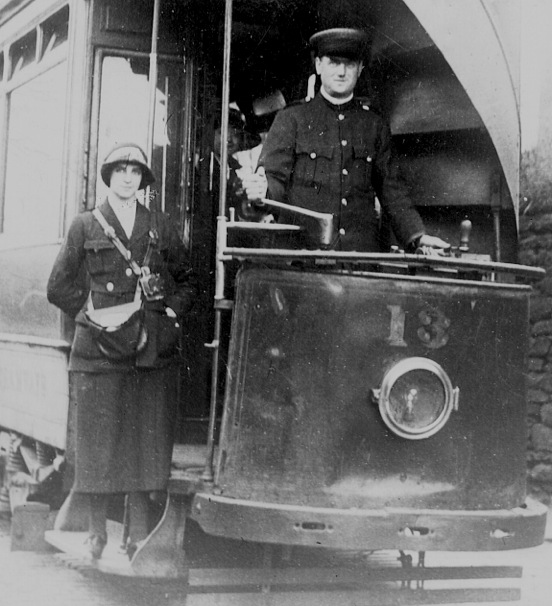
Another photograph of a conductress and a motorman on the Aspull route, but this time with a very battered looking Tramcar No 13 — photo undated, but clearly taken during or shortly after the Great War. Neither of the subjects appear to be wearing cap or collar insignia. With thanks to the National Tramway Museum.